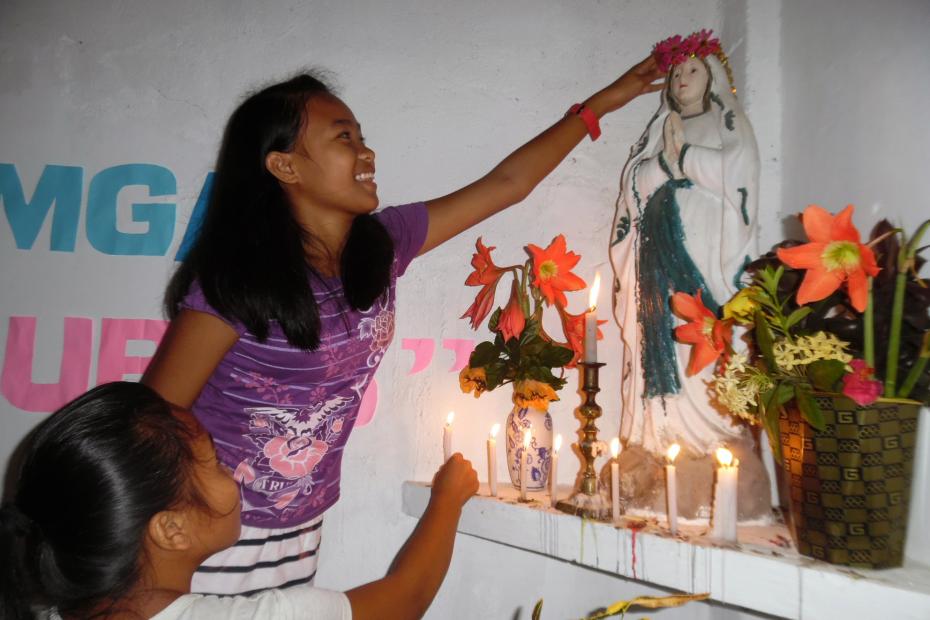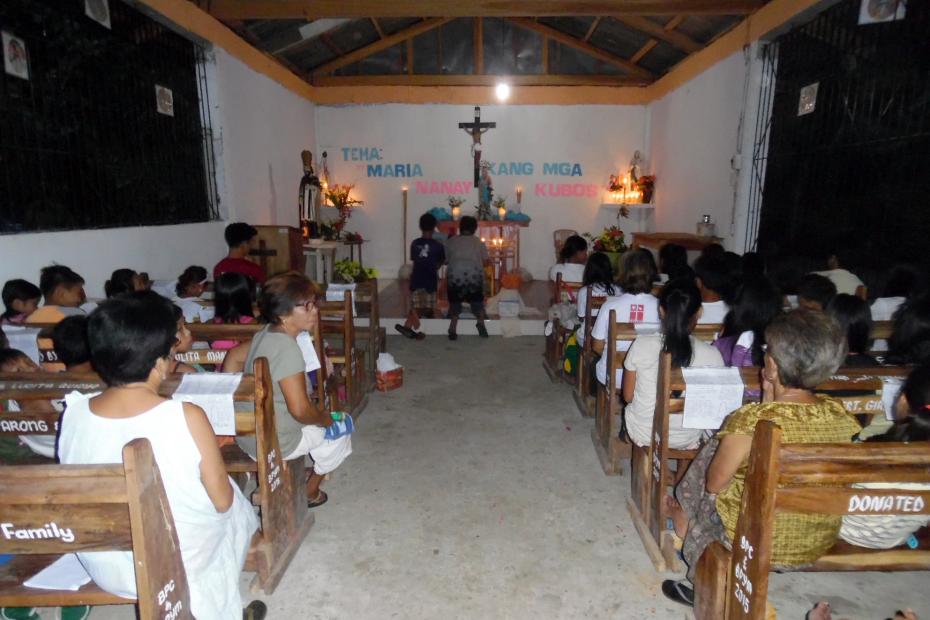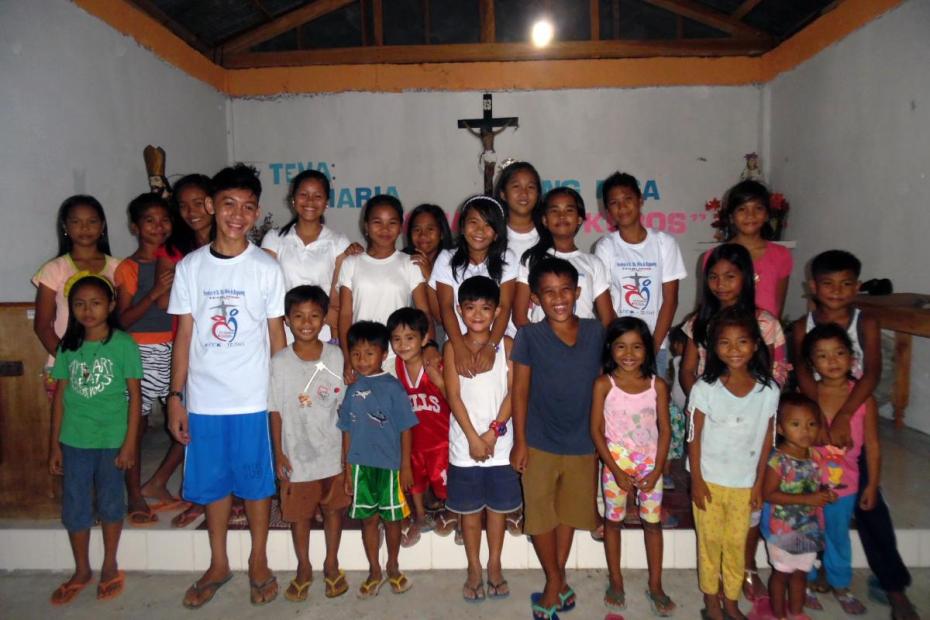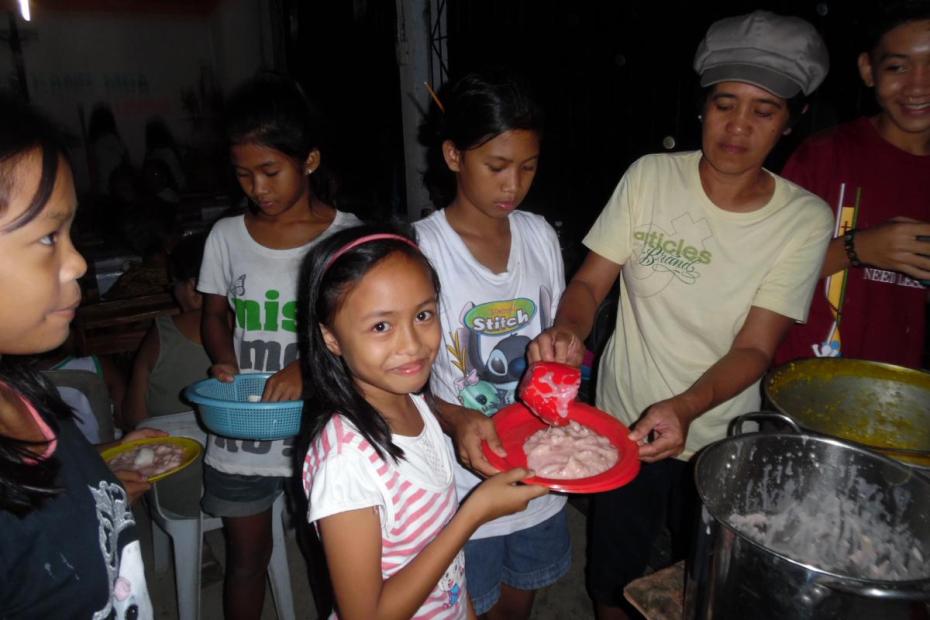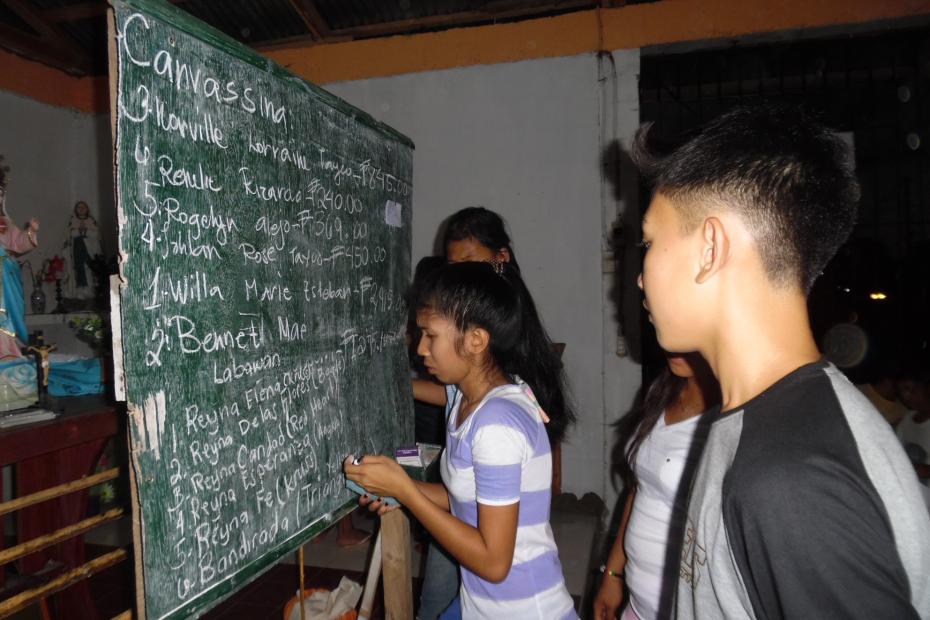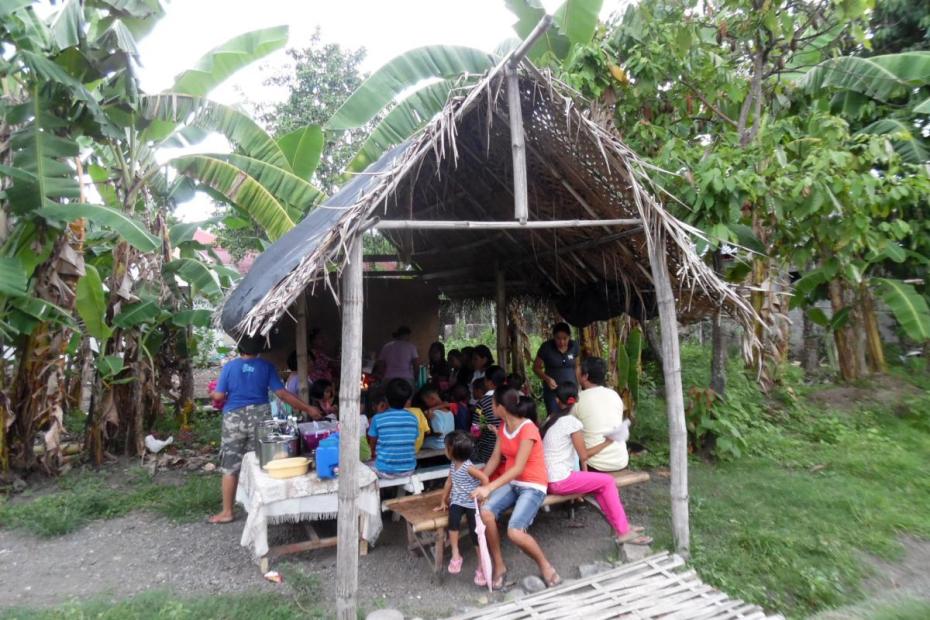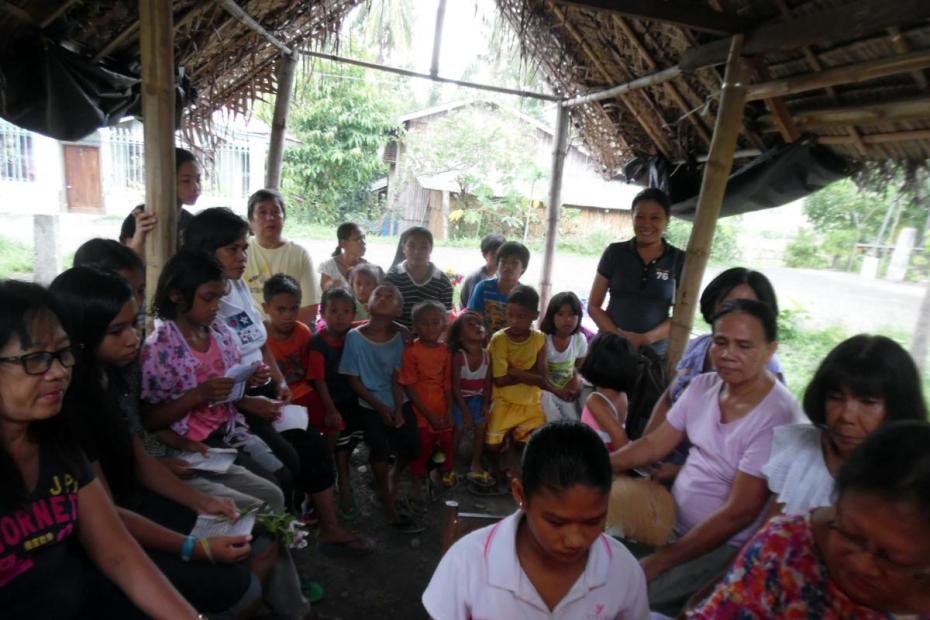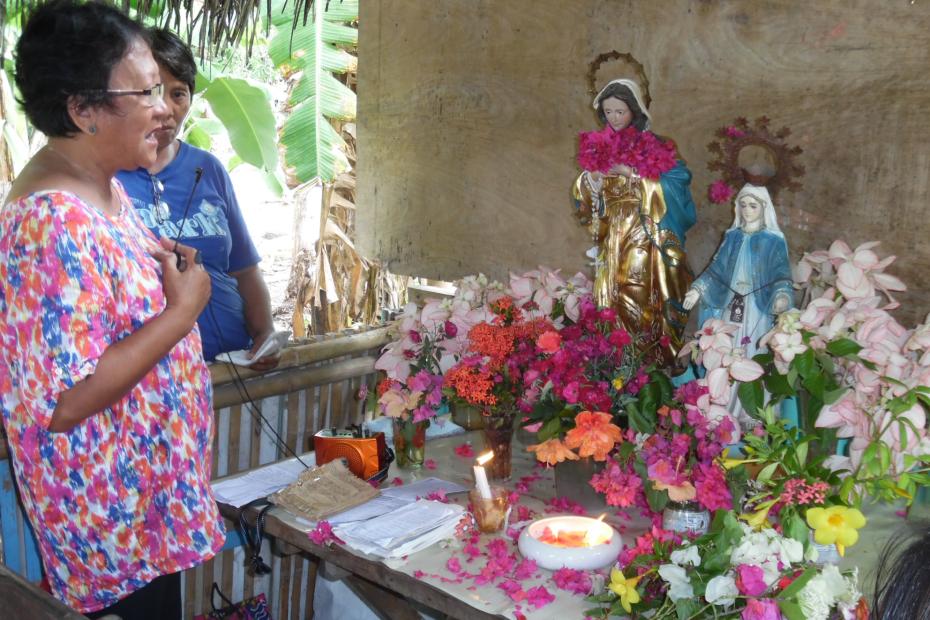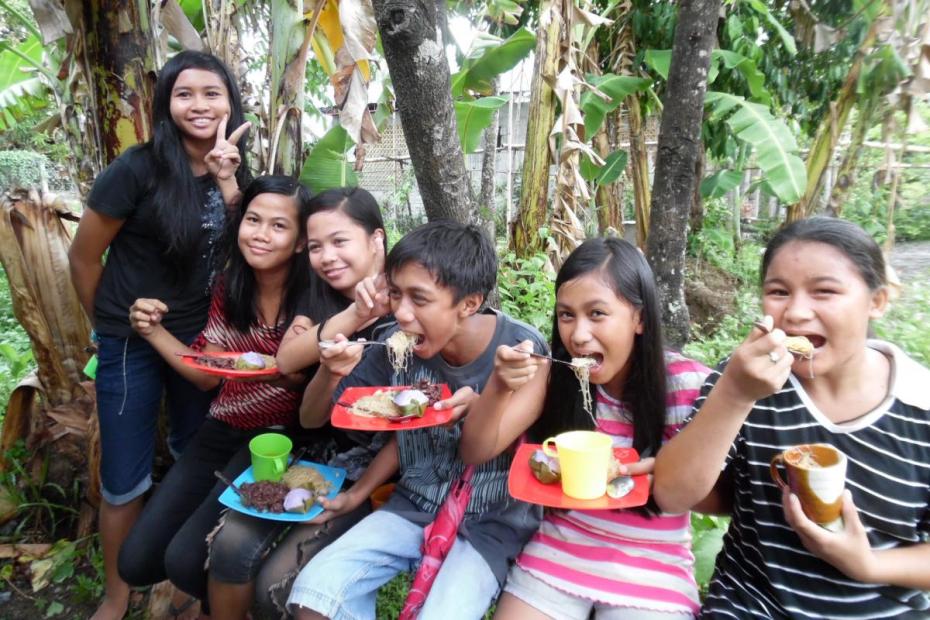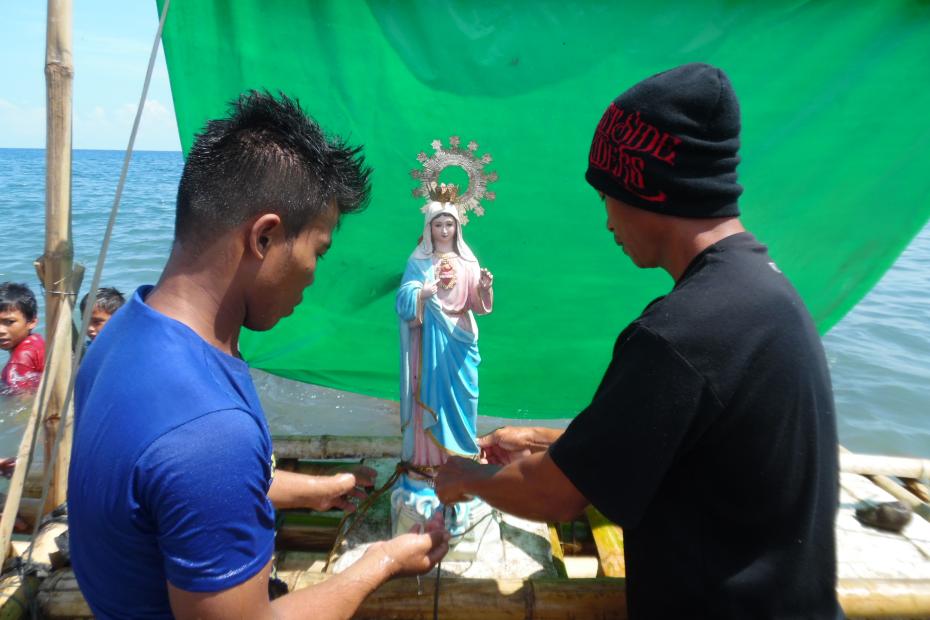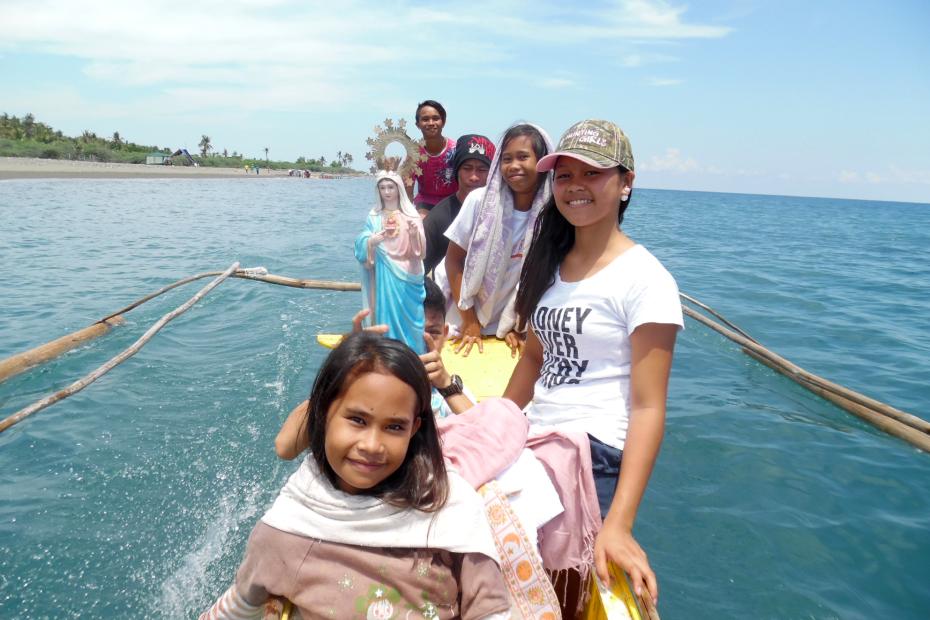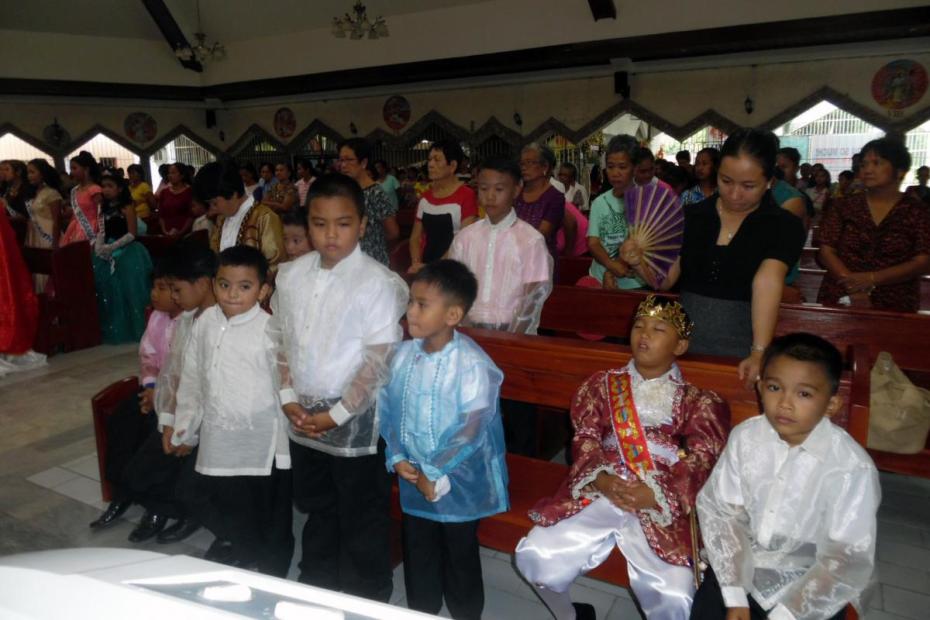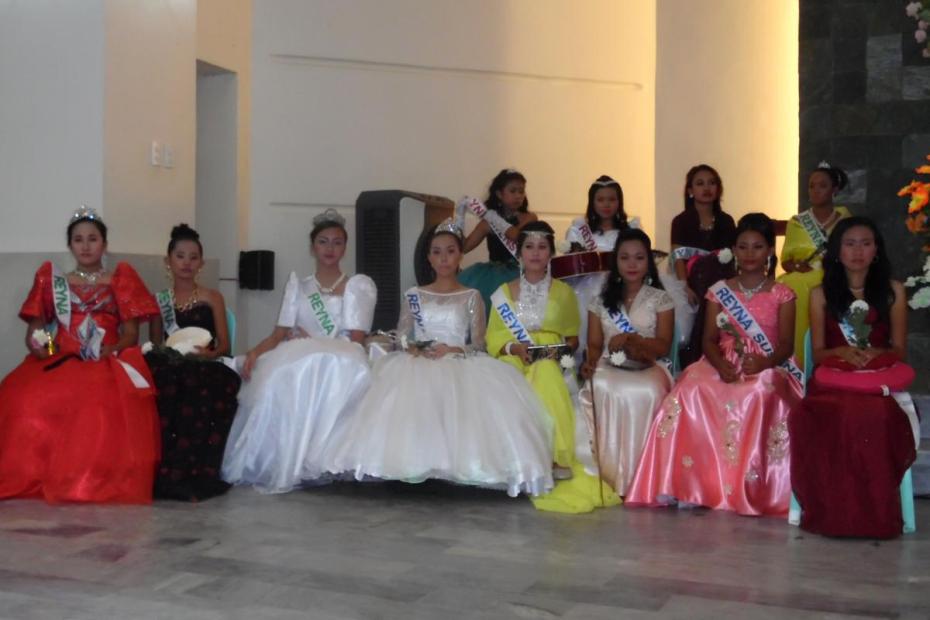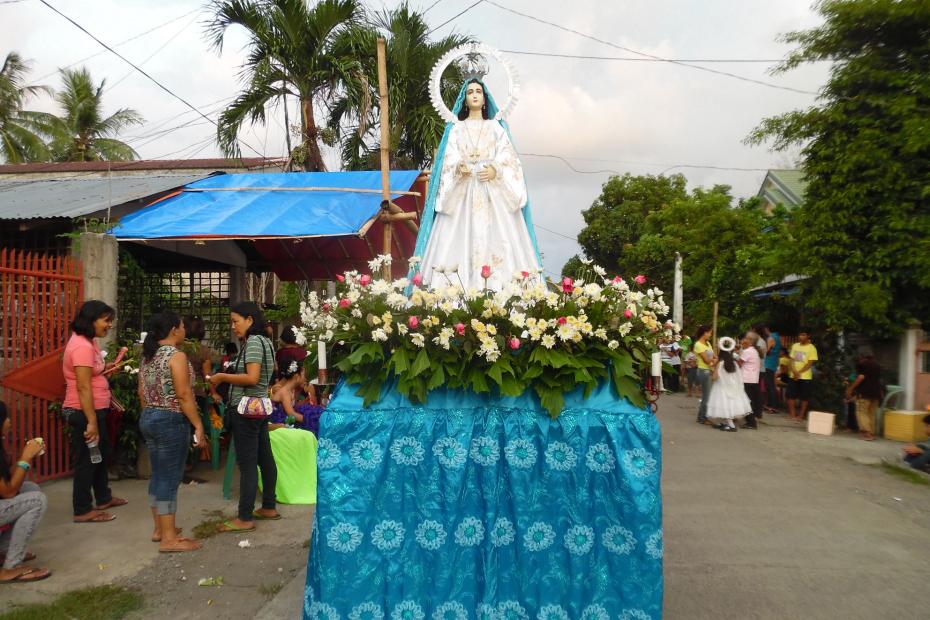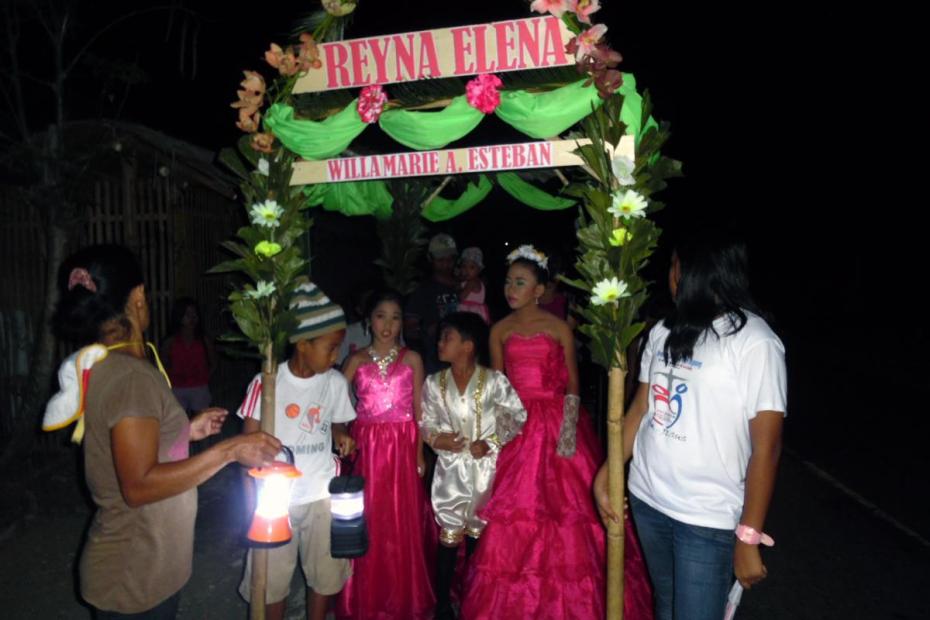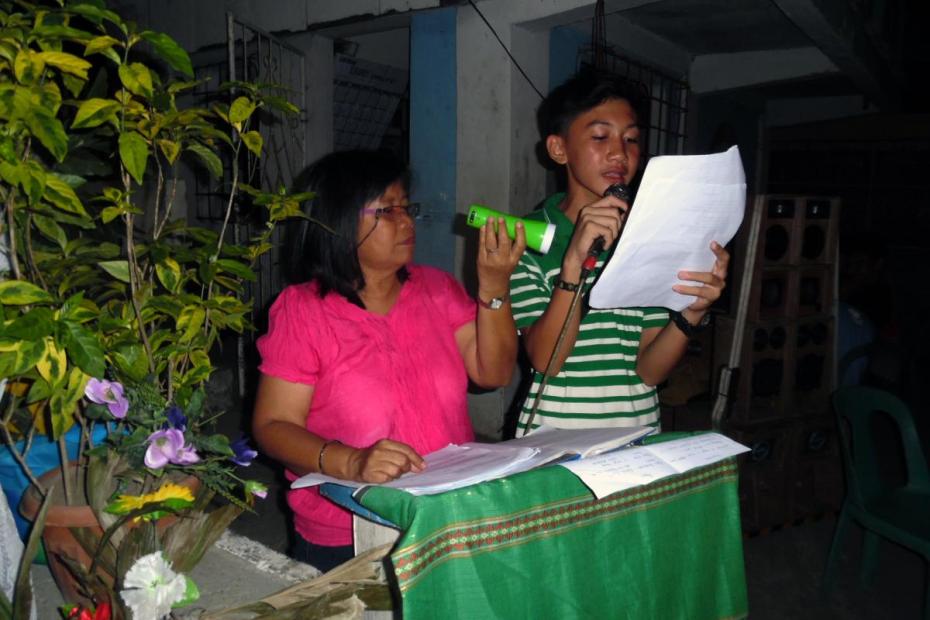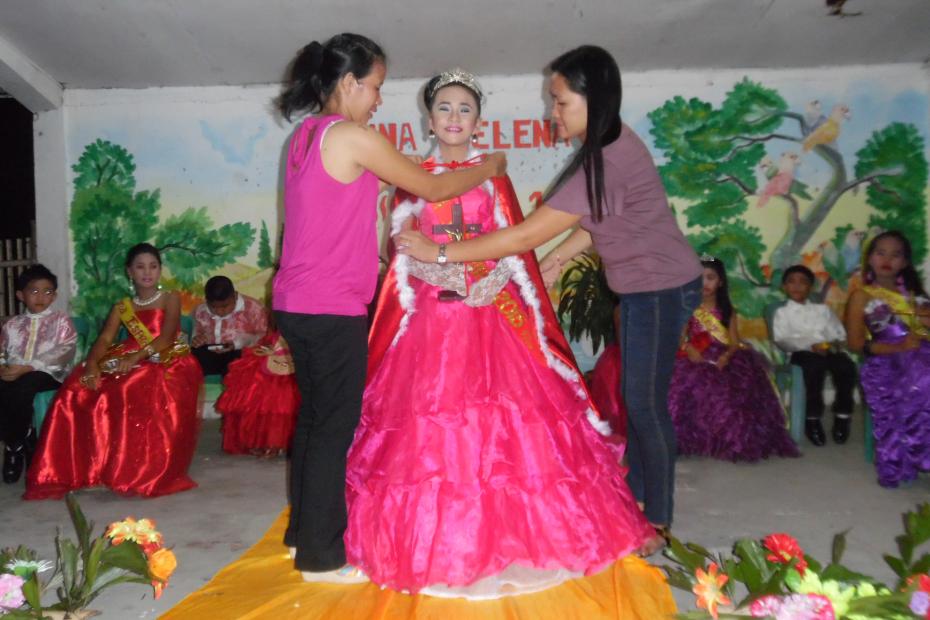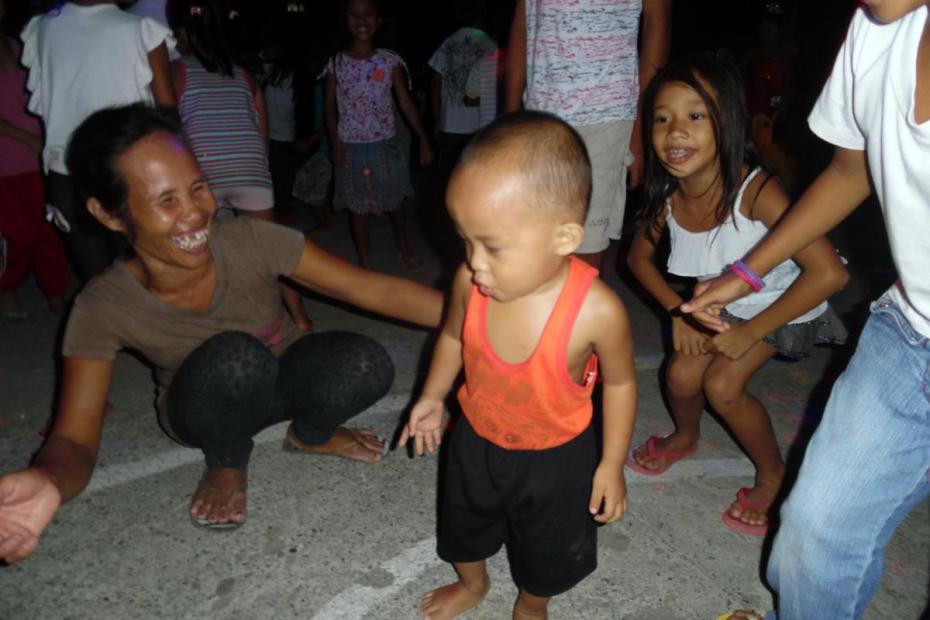Across the Philippine archipelago, a tradition known as Flores de Mayo, a daily offering of flowers to Mary, the mother of Jesus, is observed throughout the month of May. Typically the celebration culminates with a Santacruzan, a grand finale that, as its Spanish name implies, ties in a very different theological theme—the discovery of the True Cross by Reyna (Queen) Elena, or St. Helena, the mother of the Emperor Constantine. That day is celebrated with Mass in the afternoon, followed by a ritual wherein a number of young women designated as Flores de Mayo “queens” look for a hidden Cross, with the finder being designated as Reyna Elena.
A Santacruzan procession and stage event—part beauty pageant, part religious education exercise—ends the month in a distinctively Filipino style. It features elaborately dressed teenage “queens” of Flores de Mayo as biblical and allegorical figures, their consorts, and the crowning of that year’s Reyna Elena. The eating and dancing that follow last late into the night.
The town of Bugasong Antique, on the island of Visayas, one of the many places that celebrate Flores de Mayo, offers one lens into the tradition as it is currently practiced. In Bugasong, there is a long tradition of daily alay ng bulaklak, offering of flowers for Mary. A bamboo nipa hut (traditionally thatched with nipa leaves) on stilts was specially built as a munting kapilya, or small chapel, to be used as the niche for an altar to hold Mary’s image and the many flowers that were offered to her. Statues of Jesus and Mary are conspicuously displayed at the table at the center wall of the nipa hut where flower petals are showered and flowers placed daily beside the images of Jesus and Mary. Every afternoon during Flores de Mayo, a family is assigned as the donor of foods, such as rice cakes, boiled corn, boiled sweet potatoes or boiled cassava, chicken porridge and other delicacies for agape meals. After two hours of late afternoon Rosary prayers and songs, devotees eat together, dance and drink local wine, and at the end of the month an evening Santacruzan procession takes place.
Today in Bugasong it is primarily a catechetical activity for children, teens, and adult women who serve as catechists. Youth are trained through it to become magdadasal—prayer leaders or prayer warriors. In each of the town’s barangays1 , a chapel or nipa hut serves as the locus of most daily Flores de Mayo events, while the Mass is organized at the parish that covers all of these barangays.
In Bugasong’s Barangay Ilaures, youth and adult leaders gather at the small, concrete San Marcial Chapel, while in Barangay Ilaya, they celebrate the daily offering of flowers at a nipa hut.
In Bugasong’s Barangay Ilaures, youth and adult leaders no longer build a nipa hut, but gather daily each afternoon at the small, concrete San Marcial Chapel that serves the barangay. During Rosary prayers, children take turns praying the different mysteries of the Rosary and singing, after which they approach by turns to offer flowers in front of statues of Mary. After this, they share a daily agape meal prepared and offered by a volunteer family. Throughout the month, the youth make daily rounds to Catholic homes to solicit funds for the meals, sound system, stage décor and other miscellaneous expenses for the end-of-month finale and procession. They turn it into a contest to see who could gather the most money each week, and give a small prize to the winner. Collections determine eligibility for being crowned as Reyna Elena.
In Barangay Ilaya, three chapels hold Flores. In one of those, the people still celebrate the daily offering of flowers at a nipa hut built “Bayanihan style,” i.e. with contributed labor and materials. Many of the children who attend are from remote upland areas that have no Flores celebration of their own, because houses are few and far from each other. The organizers hope to catechize them, particularly in terms of devotion to Mary. Children from these places walk down daily bringing their own spoon, fork and plates to attend the Flores and join in the prayer and the agape meal. Local donors provide food for the children and school supplies to give them on the last day. They pray the Rosary, offer fresh flowers, and share in an agape meal.
Finales, Filipino style: Afloat and in the Santacruzan procession
In 2015, when this feast was documented, the final events of Flores de Mayo were held on May 29, earlier than usual, at Bugasong, due to the anticipated arrival at Bugasong parish of a replica of its patron saint, the Santo Niño of Cebu.
On Katapusan o Tapusan, the last day of Flores de Mayo, a pabitin, a square trellis made of bamboo, is erected. Goodies such as candies, fruits, and sachets of crackers are tied to the trellis with strings that can be pulled up and down repeatedly so that the children have to jump as high as they can to catch them. They might also use a goody-filled earthen jar tied to a rope and hang it from the branch of a tree or on a pole. Each child would have a turn hitting the jar with a bamboo stick while blindfolded. An agape meal is provided for the children who offered flowers during the month.
At 8 a.m. on May 29, 2015, the youth and the elders of Barangay Ilaures celebrated their own way. They processed the statue of Mary from San Marcial Chapel to the beach at Barangay Madarag, where an encampment was prepared. The image of Mary was secured to a floating bamboo raft, just offshore in the sea, and the group prayed the Rosary from onshore. After the Rosary was finished, the statue of Mary was brought to a fishing boat, along with two sacks of dried flowers gathered from the month’s offerings to Mary at San Marcial. The boat traveled along the shore, and the dried flowers were showered into the sea by youth, while those who remained onshore sang the Alleluia song. When the showering of dried flowers was done, the boat went back to the shore. The agape feast, contributed by elders and prepared by youth, was blessed by a parish priest. After eating this sumptuous lunch, a beach celebration began, including dancing and swimming.
To celebrate the end of Flores de Mayo, the youth and elders of Bugasong's Barangay Illaures process a statue of Mary to a beach and into the water at Barangay Madarag.
Later that afternoon, Santacruzan began with Mass at the Santo Niño parish in Bugasong. Following this, the parish church and the different barangay chapels each began their own Santacruzan celebrations. At the parish, the “queens” of the parish’s Flores group gathered in the parish garden compound to dramatize the search for the True Cross. In reality, Reyna Elena had already been chosen, but the “finding the Cross” ritual remains part of the celebration, and the ritual continues until the chosen Reyna Elena had found the Cross.2
The evening was marked by a procession and celebration, the event that youth had been raising money for all month. In Ilaures at around 5 p.m., youth members of the Flores de Mayo gathered at San Marcial Chapel, and at 6 p.m. they began the annual procession of the queens and consorts of the Flores de Mayo from the chapel down to the boundary between Barangays Madarag and Ilaures and back to the Barangay Ilaures plaza, where a stage was beautifully decorated for the coronation of the queens of the procession. “Queens” in the procession represent allegorical figures like charity, faith, hope; the Flores de Mayo; a variety of Marian titles; and Queen Helena, Reyna Elena. The many roles leave space for a large number of young people to participate.3 Each “queen” was accompanied by a male consort, and by a decorative arch that framed the couple and was arrayed with flowers and her name and title. A rondalla, a band of musicians, played Dios Te Salve while the devotees following the procession carried lit candles and sang. Music and announcements greeted each “queen” as she went to the stage. The coronation of Reyna Elena, whose status is signaled by a crown and a small Cross that she carries, capped the finale of the month-long celebration. Both the youth and the adults followed all this with a dancing party that lasted until the wee hours of the morning.
Baranguay Ilaures hosts a Santacruzan procession and celebration.
- 1A barangay is a geographically bounded political administrative unit, the most local form of political organization in the Philippines. The word could simply be translated as neighborhood, but in most places, neighborhoods don’t have the same organizational and political responsibilities as a barangay does.
- 2This is not, by any means, the only parish to have changed the process of choosing Reyna Elena. Other parishes select Reyna Elena based on schools’ or influential parishioners’ recommendations of young women with "brains and beauty," or on the basis of her membership in church organizations, or even on politicians’ recommendations.
- 3A full Santacruzan procession would include young women representing the following: Matusalem (Methuselah), Reyna Banderada (Queen with a banner), any of a variety of local tribal peoples, Reyna Mora (Queen Moor), Reyna ng Saba (Queen of Sheba), Rut at Noemi (Ruth and Noemi), Reyna Judit (Queen Judith), Reyna Ester (Queen Esther), Cleopatra, Samaritana (the Samaritan woman who met Jesus at the well), Sta. Veronica; the “three Marys”: Sta. Maria Magdalena (Mary Magdalene), Sta. Maria de Cleopas (Mary, the mother of James), The Blessed Virgin Mary; Allegorical titles like Reyna Fe (Queen Faith), Reyna Esperanza (Queen Hope), Reyna Caridad (Queen Charity), Reyna Sentenciada (Queen Convicted, representing the martyrs of the church); Marian titles like Reyna Abogada (Queen Advocate/Lawyer), Reyna Justicia (Queen Justice), Divina Pastora (Divine Shepherdess), Reyna de los Angeles (Queen of Angels), Luklukan ng Karunungan (Seat of Wisdom), Susi ng Langit (Key of Heaven), Reyna de los Estrellas (Queen of the Stars), Rosa Mistica (Mystical Rose), Puso ni Maria/Corazon de Maria (Heart of Mary), Reyna del Santisimo Rosario (Queen of the Most Holy Rosary), Reyna Luna (Queen Moon), Reyna Candelaria (Queen of Candles), Reyna de la Paz (Queen of Peace), Reyna de los Patriarcas (Queen of Patriarchs), Reyna de los Profetas (Queen of Prophets), Reyna de los Confesores (Queen of the Confessors), Reyna de los Martires (Queen of Martyrs), Reyna de los Apostoles (Queen of the Apostles), and of course, Reyna Elena. Each would carry a symbol to make it clear whom the young woman represents.
